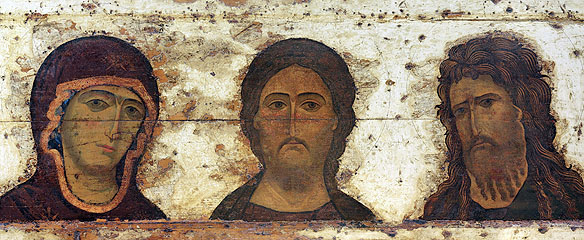Our Most Holy Lady, our intercessor and aid – 2
16 August 2014As a ‘victorious general’, Our Most Holy Lady looks down with compassion from on high on her flock, which is under visible and unseen attack from enemies, especially the ancient tyrant, the Evil One, as Saint Filotheos Kokkinos calls him. Her intercession is that means, beyond understanding, which not only honours the human race, but also strengthens it, since it frees us from the dominion of the cause of evil ways and habits. The faithful ask the Mother of God to quell the passions of their soul and to gradually disperse the murk surrounding the flesh, this thick and earthly covering. They also request that she should reinforce the spiritual movements of their soul and orientate these towards the eternal and original beauty.
Often enough, the disinclination of human nature and the lassitude of our minds make us lethargic as regards virtue, which demands effort. Hindrances and barriers make the acquisition of virtue difficult. This is why, at their first appearance, the faithful turn to the Mother of God who never ceases to love us and care for us as our own affectionate mother. She transfers her benefactions to all, without distinction, and protects them from temptations and dangers. Iosif the Hymnographer speaks poetically of Our Lady’s sleepless prayers to God, which purify the passions of the soul through her holy intercessions, at the same time granting us the saving vigilance to fulfill the will of God.
The sorrows, the calamities of life are so many, the temptations that compass us about on all sides so great that we seek the ‘powerful shelter’ of Our Most Holy Lady, and ask for protection, calling upon her name: ‘Through the bowels of your compassion, Virgin, do not despise me who am drowning in the flooding of life’s waves, but give a helping hand to me who am pained by the ills of life’. In our battle against evil, we, the faithful, are afflicted mercilessly by the surges of the passions, by the arrows of the Evil One and the rebellions of the flesh. This is why we seek Our Lady as our associate and helper, to quell the outbursts of the flesh and to overthrow the domination and triumph of the material outlook, which is what begets sin.
The faithful also request the immediate presence of God the Father, from Whom they ask to be granted ‘a watchful mind, chaste thought, a wakeful heart’. In this way, personal ascetic effort is in step with divine protection. The faithful don’t rely on their own powers, but more on the assistance of God, to Whom they also offer the whole of their being, as did the saints of the Church, and, particularly, Our Lady.
The prayers of the Mother of God support people in temptations and against the power of evil. Saint John the Damascan was of the opinion that human life would be unbearable if the faithful didn’t have Our Lady ‘talking to them and the only remaining comfort’.
If we wish to make our way to the Lord of all, to God, or to ask forgiveness for our trespasses then, in the person of Our Lady, we will find someone to take us by the hand and lead us to Him. Because of her proximity to God on the one hand, and her common ancestry with the human race, the Mother of God is continuously interceding, reconciling the creature to the Creator. With her prayers, she grants the faithful the fulfillment of their requests. And if it’s an obligation for children to pay respect to their natural parents, what tribute should they render to Our Lady, who is the cause of their spiritual birth, maturation, enrichment and deification?
Given the fact that the human race is itself to blame for its fall, and for sullying the ‘image’ [of God], it’s clear that we ourselves were incapable of arresting our progress towards desolation. The Virgin saw the catastrophic fall of our race with sorrow and compassion and sought the counter remedy for such a great affliction. Her diagnosis was that there was only one path open to her: to turn completely to God and to intercede on behalf of the whole of the human race. In consequence, she became our ambassadress, of her own free will, ‘asking to speak to God persuasively and openly’.
Through the conjunctive power, her Son Who was both God and Man, Whom she cradled in her maternal bosom, the Mother of God becomes a single realm which sustains and unites. She embraces all people, she brings together those who are scattered and reconciles them with each other and with God, as does the centre of the circle with all the radii. Our Lady is the common focus, the foundation stone and the incomparable source of gifts beyond those of nature, upon which our spiritual and rational nature draw plentifully, though without being able to transcend its perfection.
As the mid-point between two historical worlds, before and after Christ, Our Lady did not mediate solely between those two, but also between God and the whole of the human race. Her place in the mystery of divine dispensation gave her the privilege of being the only person to combine the human with the divine. In this way, writes Saint Gregory Palamas, she made God the Son of Man and people into children of God. It is from this divine capacity of hers that her role as intercessor and ambassadress for the human race derives. Since assuming this role, she has emerged as a living and breathing model and image of all good and every virtue, the greatest benefactress of heaven, earth and the hereafter.
Source: «Η Παναγία πρότυπο πνευματικής τελειώσεως», P. Pournaras Publications, Thessaloniki 2001, pp. 153-62







